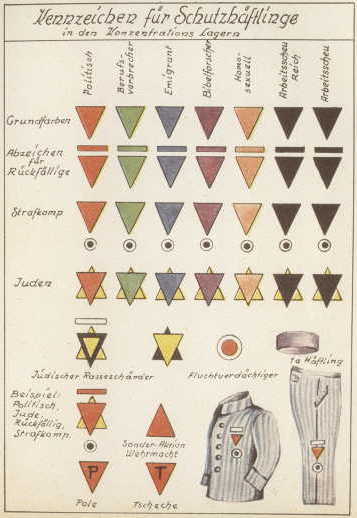


|
The Pink Triangle | history | symbol
|
||
 The pink triangle was used by the Nazis in concentration camps to identify and shame homosexuals. This symbol, which was used to label and shame, has been embraced by the gay community as a symbol of pride.
The pink triangle was used by the Nazis in concentration camps to identify and shame homosexuals. This symbol, which was used to label and shame, has been embraced by the gay community as a symbol of pride.However, in the 1930s & 1940s there was nothing celebratory about the pink triangle. Gays were forced to wear the pink triangle on their breast pockets in the concentration camps to identify them as homosexual to set them apart from other prisoners. Triangles of various colors were used to identify each category of "undesirable": yellow for Jews, brown of Gypsies, red for political prisoners, green for criminals, black for anti-socials, purple for Jehovah's Witnesses, blue for immigrants, and pink for homosexuals. The pink triangles were slightly larger than the other colored triangles so that guards could identify them from a distance. It is said that those who wore the pink triangles were singled out by the guards to receive the harshest treatment, and when the guards were finished with them, some of the other inmates would harm them as well. At the end of the war, when the concentration camps were finally liberated, virtually all of the prisoners were released except those who wore the pink triangle. Many of those with a pink triangle on their pocket were put back in prison and their nightmare continued. One of the groups that was targeted for extermination by the Nazis continues to be under attack to this day, not just verbally but physically, all over the world: homosexuals. The fact that gays were put in German concentration camps is not known by many. The stories of the survivors reveal an unimaginable cruelty and suffering. It is the same kind of senseless, irrational hatred that still haunts Gays, Jews, Blacks, and other minorities today. The Taliban in Afghanistan required non-Muslims to wear identifying badges on their clothing, just as the Nazis required their "undesirables" to wear identifying logos so long ago. History repeats itself. The list of systematic, deliberate and well-orchestrated exterminations is a long one. The Armenian Genocide of 1915 - 1918 in the Ottoman Turkish Empire, the Holocaust, the Khmer Rouge in Cambodia, the ethnic cleansing of Bosnia and the Sudan, and numerous other genocidal campaigns are testament of the world's complacency. It seems the lessons of the Holocaust and the Pink Triangle have been lost on many. Because "those who forget history are doomed to repeat it" we continue to display the Pink Triangle atop Twin Peaks. It is important to keep alive the memory of the Holocaust victims and to remind everyone of the consequences of unchecked hatred. The Pink Triangle display is also intended as an instrument to initiate discourse about hate crimes. We want to help prevent others from experiencing the results of hatred that Matthew Shepard, Allen Schindler, Brandon Teena, and countless others have been subjected to. If we can help prevent additional crimes like those committed against them, we will have been successful in our attempt to inform the public. |
||
|
|
||